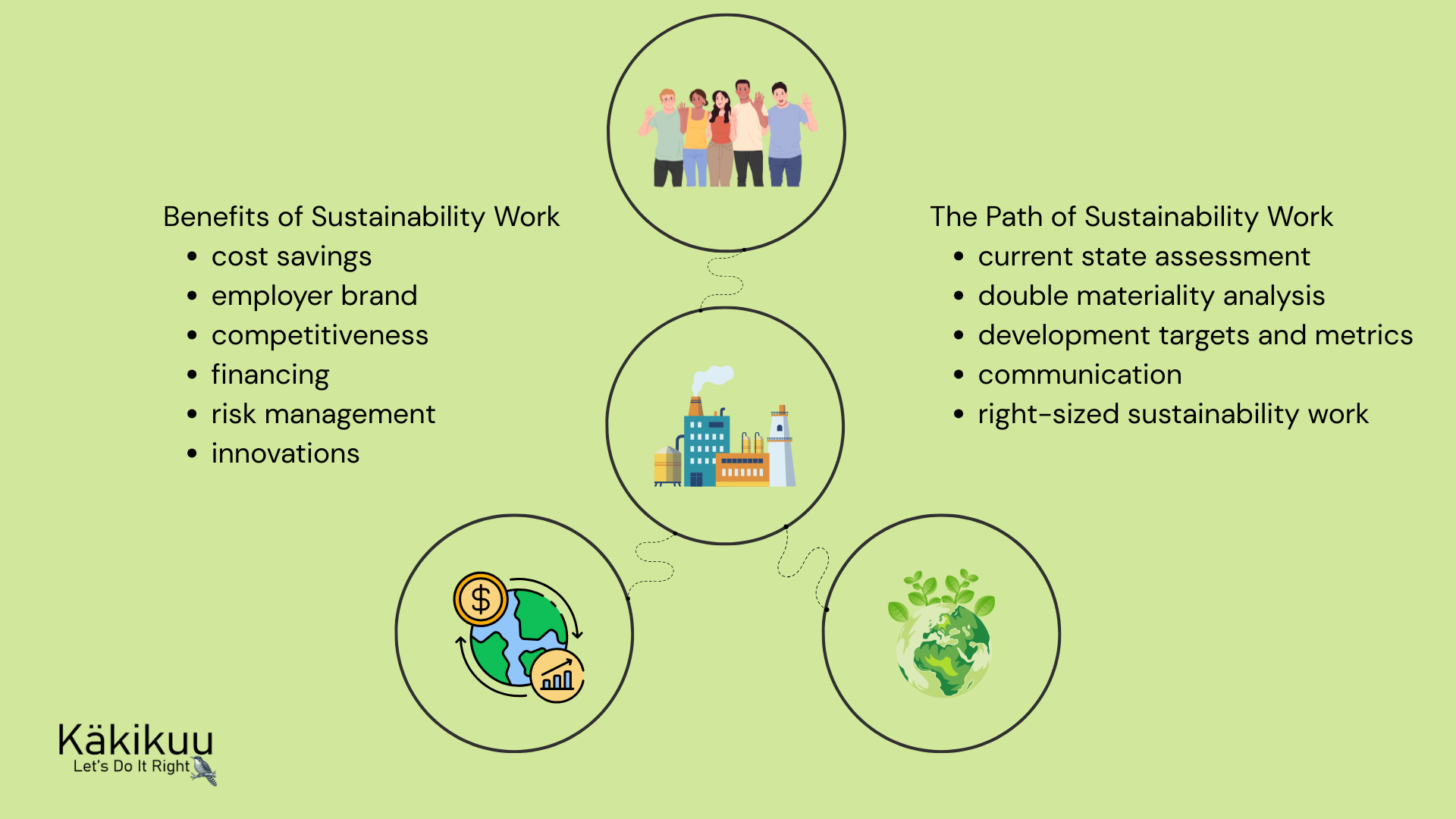Every company benefits from having a sustainability strategy. For larger companies, preparing for increasing regulation and anticipating future requirements play a crucial role. However, growing regulation also means that smaller companies—not directly subject to the rules—will inevitably face sustainability demands, especially when they are expected to provide a sustainability strategy and reporting as part of a supply chain or when participating in competitive bidding. In the future, how a company manages sustainability will also affect its access to financing and the terms under which funding is available.
The benefits of sustainability efforts in all companies also include cost savings achieved through improved resource efficiency. A sustainability strategy enables the company to allocate its resources where they have the greatest impact with the smallest possible investment. One should also not underestimate how sustainability increases interest in the company and enhances its competitiveness in both sales and recruitment. Stakeholders value companies that operate responsibly.
Despite the significant benefits of sustainability work, many companies are still hesitant to engage in systematic sustainability efforts. Research shows that the main reasons for this are limited resources and a lack of expertise. Companies often perceive sustainability as a broad and difficult-to-manage concept, with the necessary information scattered and hard to access.
What is the process of creating a sustainability strategy like, and what does it require from a company? First and foremost, it’s worth noting that this work should not be tackled alone. It’s highly advisable to hand over the responsibility to skilled experts. Doing so not only saves time, nerves, and ultimately money—it also ensures that the end result will truly serve the company in the best possible way.
In general, the process is gradual, takes several weeks, involves information gathering, reflection, iteration, and a high level of interaction.
In general, the process is gradual, takes several weeks, involves information gathering, reflection, iteration, and a high level of interaction. It’s important to involve the entire staff from the very beginning, as employees are a valuable resource whose knowledge and interest should be utilized. This brings deeper and more diverse perspectives to the process and also saves time for the entrepreneur and company leadership, as they don’t have to think everything through alone.
The process begins with a sustainability-focused assessment of the company’s current state. All companies are already taking responsible actions, although often unconsciously and without a formal sustainability plan. This assessment also includes a broad reflection on the company’s values, mission, vision, and customer promise, as well as how megatrends influence the company’s operations.
The company’s operating environment is examined primarily from the perspective of how the business impacts people, the environment, and society—and how these, in turn, affect the business. At the same time, the aim is to assess how the company responds to changes in its environment and how well it anticipates them.
In terms of stakeholder work, the process involves identifying the key stakeholders relevant to the company’s core business. This includes examining what value the company provides to these stakeholders—and what value the stakeholders provide to the company. Consideration is also given to how the company communicates with its stakeholders. A crucial question is whether the company actually knows what these stakeholders expect from it.
All these reflections ultimately serve the purpose of identifying the most essential sustainability-related risks and opportunities within the company’s core business. Through the assessment of material sustainability topics, the process naturally progresses toward defining the key sustainability themes for the strategy period, along with corresponding actions and indicators.
What follows is leadership and communication. As part of leadership, the company defines how sustainability work will be managed and assigns responsibilities accordingly. Methods for implementing sustainability throughout the organization are also agreed upon. In addition, a reliable reporting system is established, along with clear and systematic communication. After this, the company begins to implement the strategy, continuously improves its practices, and progresses step by step toward its goals.
The process described above may sound difficult and time-consuming—and a sustainability strategy is not created with the snap of a finger. It requires commitment and time, especially for reflection, from both management and staff. To support this, the company receives an introduction to sustainability topics from an expert, along with a ready-made list of questions and tasks that make it easy to move forward in the process, as well as continuous support throughout.
It’s difficult to give a universally applicable estimate of the time required to create a sustainability strategy, as there are many variables—such as the company’s size, industry, scope of operations, and level of enthusiasm and commitment to sustainability. As a general guideline, an SME should be prepared to allocate the equivalent of 1–3 working days, divided into smaller sessions over a period of 2–3 months. The actual writing and visualization of the strategy is handled by the expert.
The process of creating a sustainability strategy is highly rewarding.
The process of creating a sustainability strategy is highly rewarding. Thorough reflection, meaningful discussions, and a clear plan help clarify not only the company’s sustainability work but also its overall business strategy—where the company currently stands and where it is heading. Once completed, a collaboratively developed strategy provides a clear path forward, enabling the company to respond to the challenges of societal transformation and succeed well into the future. The investment pays off faster than one might expect.


